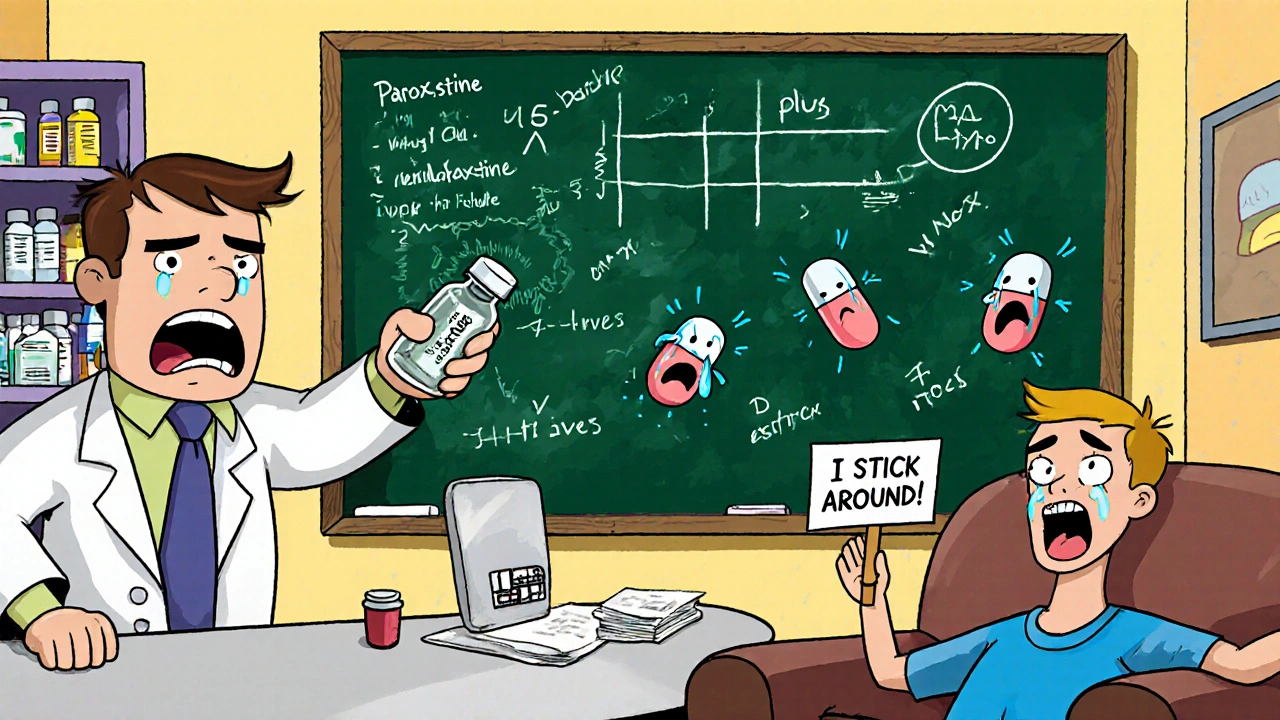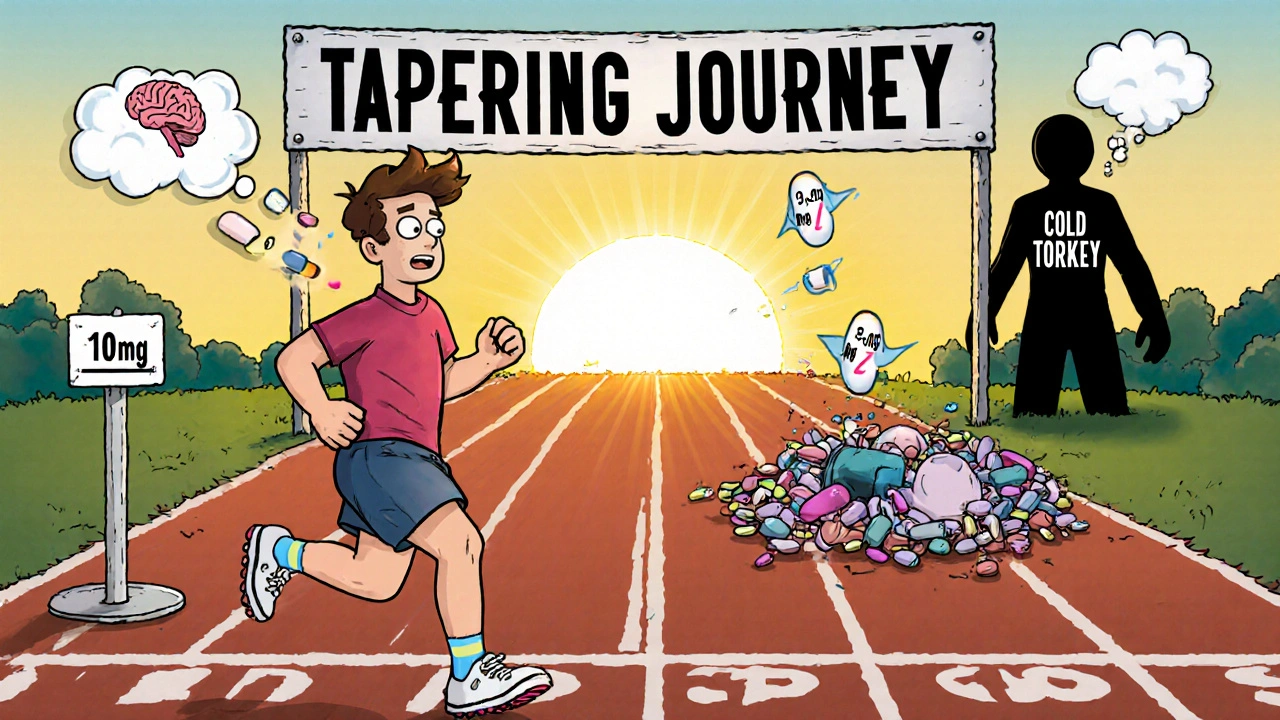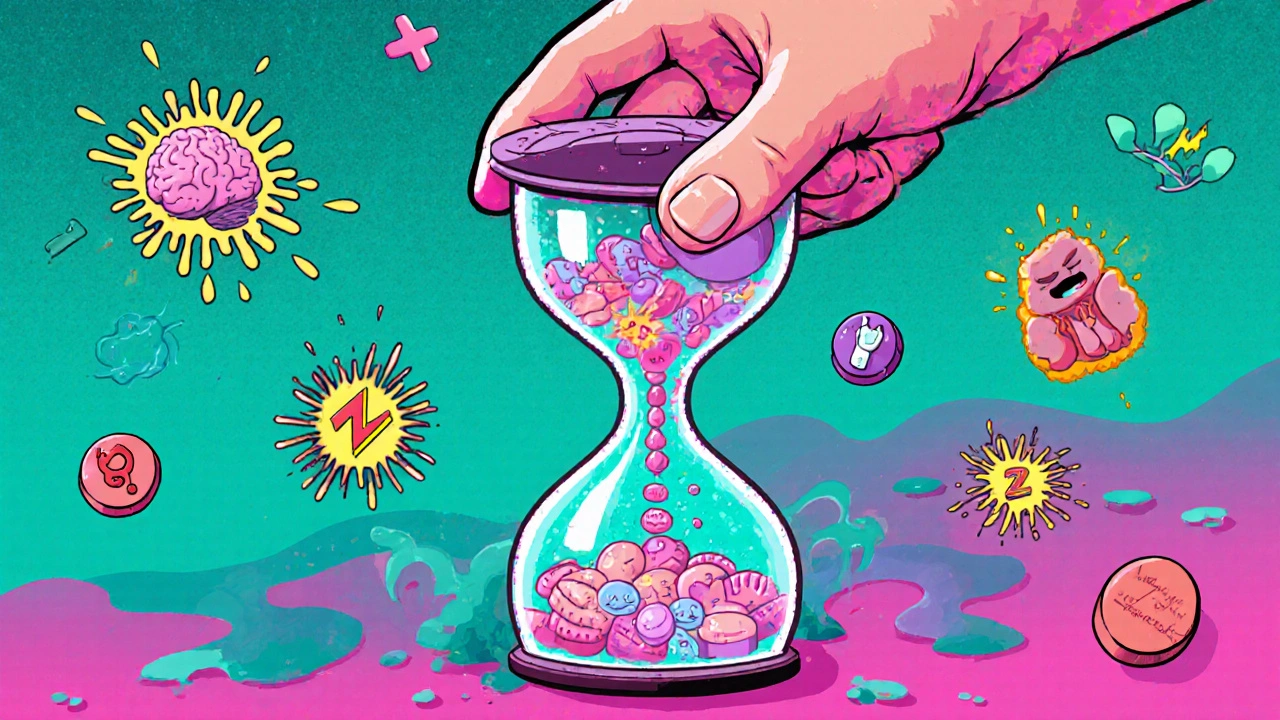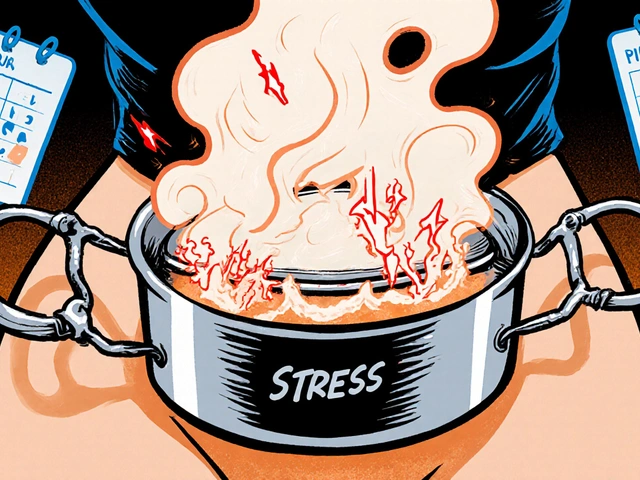Antidepressant Tapering Calculator
Create Your Personalized Tapering Schedule
This tool generates a step-by-step tapering schedule based on your antidepressant type and current dose. Always consult with your healthcare provider before making any changes to your medication.
Your Antidepressant
Your Personalized Tapering Schedule
Based on the medical guidelines in the article, your recommended tapering schedule is shown below.
| Dose (mg) | Duration | Notes |
|---|---|---|
| 20.0 | 2 weeks | Start with this dose |
| 15.0 | 3 weeks | Continue monitoring symptoms |
| 10.0 | 3 weeks | Reduce by 25% from previous dose |
| 5.0 | 4 weeks | Final stages require micro-tapering |
| 0.0 | Stop | Complete taper |
Important Considerations
The final 10-25% of your taper is typically the most difficult. Consider micro-tapering (reducing by only 2-5% at a time) for the last 5-10mg. Always pause your taper if you experience withdrawal symptoms and consult your doctor before making any changes.
What to watch for:
- Dizziness or lightheadedness
- Electric shock sensations in the head ("brain zaps")
- Nausea, vomiting, or diarrhea
- Insomnia or vivid dreams
- Increased anxiety or irritability
Why Tapering Antidepressants Matters
Stopping antidepressants suddenly doesn’t just feel weird-it can trigger real, sometimes severe, physical and emotional reactions. People report dizziness, brain zaps, nausea, insomnia, and overwhelming anxiety. These aren’t signs of depression coming back-they’re antidepressant withdrawal, also called discontinuation syndrome. Up to 86% of people who quit cold turkey experience some version of this, especially with medications like paroxetine or venlafaxine that leave the body quickly. The good news? You don’t have to power through it. A slow, thoughtful taper can cut those symptoms by more than half.
How Tapering Works: It’s Not One-Size-Fits-All
Tapering means slowly lowering your dose over time, not stopping all at once. The goal isn’t just to avoid discomfort-it’s to give your brain time to readjust its chemical balance. When you take an antidepressant daily, your brain adapts. When you stop, it needs to relearn how to function without it. A rushed taper forces that adaptation to happen overnight. A slow one lets it happen in steps.
But here’s the catch: there’s no universal schedule. What works for someone on fluoxetine might wreck someone on sertraline. Why? Because of half-life-the time it takes for half the drug to leave your system. Fluoxetine sticks around for days. Paroxetine? Gone in hours. The shorter the half-life, the faster you need to taper.
Standard Tapering Guidelines by Medication Type
Here’s what most experts agree on, based on clinical guidelines from the UK, Australia, and Harvard:
- Fluoxetine (Prozac): Because it stays in your system for up to 4 days, you can taper faster. A 10-25% reduction every 2 weeks is often enough. Some people even go from 20mg to 10mg to 5mg over 4-6 weeks without major issues.
- Sertraline (Zoloft), Citalopram (Celexa), Escitalopram (Lexapro): These have medium half-lives. Cut by 10-25% every 2-4 weeks. For example, if you’re on 20mg of escitalopram, drop to 15mg for 3 weeks, then 10mg for another 3 weeks, then 5mg for 2-4 weeks before stopping.
- Paroxetine (Paxil): One of the worst for withdrawal. Even small drops can trigger symptoms. Try 10% reductions every 3-4 weeks. Some people need to switch to a liquid form to cut by just 1-2mg at a time.
- Venlafaxine (Effexor): Similar to paroxetine. Dose reductions should be no more than 37.5mg every 5-7 days. Going from 150mg to 112.5mg to 75mg, then slower from there.
- MAO inhibitors (e.g., phenelzine): These require a 14-21 day washout before starting any other antidepressant. Don’t skip this. Mixing them can cause serotonin syndrome-a dangerous spike in brain chemicals.
The Last 10% Is the Hardest
Most people think the worst part is the first few drops. It’s not. The final 10-25% of the taper is where 50% of withdrawal symptoms show up. That’s because your brain is now running on almost no medication, and even tiny changes matter. A 5mg drop from 20mg to 15mg? Fine. A 5mg drop from 10mg to 5mg? That’s a 50% reduction. Your receptors are screaming.
That’s why experts now recommend micro-tapering for the final stretch. Instead of cutting by 10% each time, drop by 2-5% every 1-2 weeks. If you’re on 10mg of sertraline, go to 9.5mg for 2 weeks, then 9mg, then 8.5mg. Some people use liquid formulations to make these tiny cuts possible. A 2023 study from King’s College London found this approach reduced severe symptoms by 62% compared to standard tablet tapering.

When to Switch Medications
Sometimes you’re not stopping-you’re switching. Maybe your doctor wants to move you from venlafaxine to sertraline. You can’t just stop one and start the other. You need a plan:
- Taper & Switch Immediately: Slowly reduce the old drug while slowly increasing the new one. For example: drop venlafaxine by 37.5mg every 5 days while adding 25mg of sertraline every 5 days. Done over 2-3 weeks.
- Taper & Wait: Only for MAOIs. Stop the old drug, wait 14-21 days, then start the new one.
- Direct Switch: Rare. Only works with fluoxetine because it lingers so long. You can stop fluoxetine and start another drug the next day.
What to Watch For
Withdrawal symptoms usually show up within 1-5 days after a dose cut. Common ones include:
- Dizziness or lightheadedness (63% of cases)
- Electric shock sensations in the head (“brain zaps”)
- Nausea, vomiting, or diarrhea (45%)
- Insomnia or vivid dreams
- Increased anxiety or irritability
- Flu-like symptoms: fatigue, chills, muscle aches
These aren’t signs your depression is returning. They’re your nervous system reacting to the change. If you feel them, pause your taper. Stay at your current dose for another 1-2 weeks. Don’t rush. Most symptoms fade within days once you stabilize.
Why Most People Fail at Tapering
Three big reasons:
- They follow vague advice. “Taper gradually” isn’t enough. You need numbers: how much, how often.
- They don’t track symptoms. Keep a simple log: date, dose, symptoms, sleep quality. You’ll spot patterns.
- They panic when symptoms hit. 73% of people think withdrawal = relapse. They go back on the drug, then feel trapped. You’re not failing-you’re adjusting.
The Maudsley Prescribing Guidelines (2022) are the gold standard for exact milligram reductions. If you’re unsure, ask your doctor for a copy-or find it online. It lists step-by-step plans for 17 different antidepressants.

What’s New in 2025
Two big advances are changing how tapering is done:
- Liquid formulations: Now available for sertraline, citalopram, and escitalopram. Allows 1mg cuts-something tablets can’t do. This is a game-changer for sensitive people.
- Genetic testing: A 2023 study showed your CYP2D6 and CYP2C19 genes predict how fast you metabolize antidepressants. Slow metabolizers need slower tapers. Testing isn’t routine yet, but it’s coming.
Major organizations like the American Psychiatric Association are updating their guidelines in 2024 to include these methods. The message is clear: slow, precise, and personalized works best.
When to Call Your Doctor
Not every symptom needs a panic call. But if you experience:
- Severe confusion or hallucinations
- Heart palpitations or chest pain
- Extreme agitation or suicidal thoughts
- Symptoms lasting more than 3 weeks after a dose change
-contact your provider immediately. These aren’t normal withdrawal signs. You might need to pause the taper, adjust your plan, or rule out something else.
Final Thoughts: Patience Wins
Tapering isn’t a race. It’s a reset. Rushing it increases your risk of relapse by 40%. A slow taper-6 to 12 weeks, sometimes longer-gives you the best shot at staying well. Don’t let anyone tell you “you should be done by now.” Your brain isn’t on a timeline. It’s on its own rhythm. Listen to it. Track your progress. Adjust as you go. And remember: the goal isn’t just to stop the pill. It’s to stop feeling like you need it.
How long should I taper off antidepressants?
There’s no single answer. For most SSRIs, a minimum of 4 weeks is recommended, but 6-12 weeks is common. For medications with short half-lives like paroxetine or venlafaxine, 2-6 months may be needed. The final 25% of the taper often takes the longest-some people spend weeks on just 5mg or less.
Can I taper off without my doctor’s help?
Technically, yes-but it’s risky. Antidepressants affect brain chemistry in complex ways. Without medical guidance, you might misinterpret symptoms, reduce too fast, or miss signs of relapse. Always work with a prescriber who understands tapering protocols. If your doctor isn’t familiar, ask for a referral to a psychopharmacologist.
Will I feel better after stopping?
Many people do-but not right away. Withdrawal symptoms can last 1-6 weeks. After that, some report improved energy, clearer thinking, or fewer side effects. Others feel emotionally flat at first. Give it 2-3 months. If you’re still struggling after 6 months, talk to your doctor about whether depression has returned or if you need support.
Are liquid antidepressants better for tapering?
For people who need very small dose reductions-especially in the final stages-yes. Liquid formulations allow cuts as small as 1mg, which tablets can’t do. This is especially helpful for those who’ve had bad withdrawal before or are sensitive to changes. Ask your pharmacist if your medication is available in liquid form.
What if my symptoms come back after stopping?
It could be withdrawal lingering, or it could be depression returning. Withdrawal symptoms usually peak within 2 weeks and fade after that. Depression symptoms tend to build slowly over weeks or months and include persistent low mood, loss of interest, and hopelessness. If you’re unsure, keep a daily journal of your mood, sleep, and energy. Bring it to your doctor. They can help you tell the difference.
Is it safe to taper while pregnant or breastfeeding?
This requires specialized care. Some antidepressants cross into breast milk, and sudden changes can affect the baby. Never taper during pregnancy or breastfeeding without consulting a psychiatrist who specializes in perinatal mental health. In many cases, continuing a low dose is safer than stopping abruptly.
Can I use supplements or herbs to ease withdrawal?
There’s no strong evidence that supplements like omega-3s, magnesium, or St. John’s Wort reliably reduce withdrawal symptoms. Some may even interfere with your medication. Don’t self-treat. Talk to your doctor before adding anything. Focus on sleep, hydration, and gentle movement-these have proven benefits.







Comments
Justin Vaughan
November 1, 2025 AT 21:52 PMThis is the most practical guide I've seen on tapering. I went from 40mg of sertraline down to 5mg over 7 months using 10% drops every 3 weeks. The last 2mg took me 6 weeks. No brain zaps, no nausea. Just slow, steady, and silent. Your brain doesn't care about your calendar.
Track everything. Even if you think it's pointless. Sleep quality, mood, energy. I kept a notes app open. Looking back, I could see patterns I never noticed while in it. It's not magic. It's biology.
Matthew Kwiecinski
November 3, 2025 AT 10:03 AMThe Maudsley Guidelines are the only source that matters. Everything else is guesswork. If your doctor doesn't know them, find one who does. I've seen too many people get thrown into withdrawal because someone thought 'gradual' meant cutting 25% every week. That's not gradual. That's negligence.
Brittney Lopez
November 4, 2025 AT 14:37 PMI was terrified to taper off citalopram after 8 years. But I used the liquid form and dropped 1mg every 10 days. Took me 5 months. Felt like a slow exhale instead of a crash. I’m not saying it’s easy, but it’s doable. You’re not weak for needing time.
Dade Hughston
November 5, 2025 AT 07:41 AMI tried tapering once and it was a disaster I got brain zaps so bad I thought I was having a stroke and then my dog started barking at 3am like he knew something was wrong and I cried for 45 minutes in the shower because I felt like my soul was being rewired by a toddler with a soldering iron and now I’m back on the meds and honestly I dont care what anyone says I just want to sleep without feeling like my head is full of static electricity and why does no one talk about how lonely this feels
Manuel Gonzalez
November 7, 2025 AT 02:11 AMThe final 10% is where most people quit. It’s not because the symptoms are worse-it’s because hope starts to fade. You’ve been at this for months. You’re tired. You think you’re failing. But you’re not. You’re doing the hardest part. That’s when micro-tapers save lives. A 2% drop isn’t a setback. It’s strategy.
S Love
November 7, 2025 AT 09:18 AMI’m from a country where antidepressants are still stigmatized. I’ve helped three friends taper using this exact method. One switched from paroxetine to liquid escitalopram. Took 9 months. No hospital visits. No relapse. It’s possible. You just need patience and the right tools. And a good journal.
Pritesh Mehta
November 8, 2025 AT 11:48 AMIn India we don’t have access to liquid formulations. We use tablets and crush them with a mortar. It’s crude but it works. My cousin tapered off venlafaxine using this method-ground 37.5mg into powder, mixed with water, and took 10% less every 6 days. He didn’t know about King’s College study but he followed the same logic. Human instinct beats Western protocols sometimes. Also, we don’t have psychiatrists for everyone. We adapt.
Billy Tiger
November 9, 2025 AT 06:57 AMAll this science is just corporate propaganda to keep people on meds longer. Big Pharma doesn’t want you off their drugs. They invented withdrawal syndrome so you’d think you need them forever. The real problem is you’re not healing mentally-you’re just chemically numb. Go off cold turkey. Your body will reset. No one ever died from stopping antidepressants. But millions die from being medicated to death
Jim Peddle
November 10, 2025 AT 14:51 PMYou realize this entire tapering framework is based on a 2023 King’s College study funded by a pharmaceutical consortium that owns the patents on liquid formulations? The ‘brain zaps’ are likely neuroinflammatory responses from long-term SSRI use, not withdrawal. The real issue is that we’ve turned emotional regulation into a pharmacological problem. This isn’t medicine. It’s a dependency ecosystem. And now they’re selling you $200 liquid bottles to keep you compliant.
Katie Ring
November 11, 2025 AT 01:01 AMThe author is right. The last 10% is where the soul fights back. I spent three weeks at 2.5mg of escitalopram because I couldn’t take the emotional numbness anymore. I wasn’t depressed. I was empty. And that’s worse. I stopped. Not because I was scared. Because I finally felt like me again. No pills. No plans. Just me.